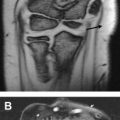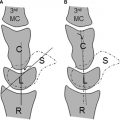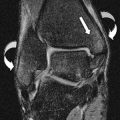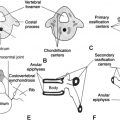This article reviews useful diagnostic criteria and imaging pitfalls more commonly encountered in the knee. Knowledge of the anatomy and pathologic conditions presented can lead to more accurate and useful interpretation that can assist clinicians in patient care.
With its excellent soft tissue contrast capabilities and ease of acquisition of multiple imaging planes, magnetic resonance (MR) imaging has become the standard for definitive evaluation of the knee across the spectrum of pathologic conditions. The technique has excellent ability to evaluate the bone, cartilage, ligaments, and tendons in a single examination. In short, it is highly accurate with sensitivity and specificity of up to 90% to 95% for the menisci and nearly 100% for the cruciate ligaments. Like all joints imaged with MR imaging, the knee has many potential pitfalls and anatomic variations. The interpreting radiologist must be well versed in this knowledge to avoid reporting pathologic conditions when it is not present and to not misinterpret subtle diagnoses for normal variation and thus deprive a patient of a timely path toward appropriate treatment. In this article, multiple examples of variations and potential pitfalls are provided along with examples of knee internal derangements at MR imaging, which contrast the mimics. Also included are several examples of pathologic conditions that may clinically mimic more serious lesions, and if these conditions are not characterized properly, then the pitfall of potentially unnecessary invasive treatments could ensue.
MR imaging of the knee: technical considerations and pulse sequences
A dedicated knee coil is recommended for optimal knee imaging. There are multiple products in use with similar results. Such coils are of considerate expense in the tens of thousands of dollars but are vital for optimal results. A small field of view is ideal in the range of 14 to 16 cm depending on patient size. Most centers use a 4-mm slice thickness with a range of 3 to 5 mm being most often used. A 0.4-mm interslice gap reduces cross talk but is not needed if volume imaging is used. Typical matrices used for the knee are 256 × 192 or 256 × 256. Positioning the patient with the knee at rest is usually at about 5° of external rotation. This position optimizes the evaluation of the anterior cruciate ligament (ACL), placing it in the plane of sagittal imaging. When selecting pulse sequences, it is an important consideration to have a sequence with a short echo time (TE) to best evaluate for meniscal tears and the posterior cruciate ligament (PCL). This evaluation may be done with conventional spin echo T1-weighted (T1W), proton density (PD), or gradient echo sequences. For meniscal imaging, a sagittal PD sequence with fat suppression is advised. The fat suppression provides better aesthetic evaluation of the menisci (much like meniscal windows did). For evaluation of the cruciate ligaments, cartilage, and bones, a T2-weighted (T2W) sequence with fat suppression is recommended. A gradient echo imaging is adequate for the evaluation of cartilage and ligaments but is suboptimal for the evaluation of pathologic conditions of bone marrow, and thus another marrow-sensitive sequence is needed. The coronal plane is useful for the examination of the collateral ligaments and cartilage and also gives a second evaluation of the cruciate ligaments when the sagittal plane is not conclusive. Fat-suppressed T2W imaging is especially useful for ligaments, cartilage, and bone marrow. In addition, the identification of meniscocapsular separation is made easier with this technique. Fluid noted between the medial meniscus and medial collateral ligament (MCL) is diagnostic of a meniscocapsular separation. A normal small fat pad in this region may get misconstrued as fluid if fat suppression is not used. T1W imaging in the coronal plane was often used yet added no advantage over T2W imaging and has been largely replaced with T2W imaging. In the axial plane, evaluation of the patellar cartilage, trochlear cartilage, and medial patellar plicae can readily be performed. There is also a second or third look at the cruciate ligaments and a second look at the collateral ligaments. MR arthrography has had some utility in the differentiation of postoperative changes versus a new meniscal tear, but this discussion is beyond the scope of this article.
Menisci
The menisci are C-shaped, fibrocartilaginous structures and are thicker at their periphery than at their center. The menisci are made of thick collagen fibers mostly arranged circumferentially, with radial fibers extending from the capsule, between the circumferential fibers. The superior surfaces of the menisci are concave and the inferior surfaces are flat, which facilitates congruent relationships of the femur and tibia. The posterior horn of the medial meniscus is larger than the anterior horn. In the lateral meniscus, the anterior and posterior horns are equal in size. It is an abnormal finding if the posterior horn of a meniscus is smaller than the anterior horn. In adults, a normal meniscus is low in signal. In children and adolescents, there is intermediate to high signal in the posterior horns near their attachment to the capsule, related to normal vascularity ( Fig. 1 ). Because of the vascularity at the periphery of the menisci, tears in this region may be repaired. However, at the center, where there is minimal vascularity, most of these tears cannot be repaired.

Abnormal signal detected within a meniscus, which does not abut the articular surface indicates intrasubstance or myxoid degeneration ( Fig. 2 ). This degeneration may be related to wear and tear with aging, but this relation is not entirely certain. This degeneration is inconsequential in that it is asymptomatic and does not correlate with risk of tears. The important consideration is to differentiate it from meniscal cysts, which may be symptomatic and are discussed later.
High signal that can clearly be seen to disrupt an articular surface of the meniscus is diagnostic of a tear. Signal not disrupting the surface, as mentioned earlier, indicates degeneration. In about 10% of cases, the disruption of the articular surface is not always clearly identified. In these cases, the site of the questionable finding should be reported for the treating surgeon to correlate with their clinical examination and, if needed, arthroscopy.
Many patterns of meniscal tears have been described. A brief review of the imaging findings of the tears is provided to contrast the multiple mimics of tears described later. Important features describing tears include the site in the meniscus, extent of tear, and associated findings, such as meniscal cysts. Most common is the oblique or horizontal tear (synonyms) of the undersurface of the posterior horn of the medial meniscus, believed to most commonly be degenerative and not related to trauma ( Fig. 3 ). Vertical longitudinal tears or bucket-handle tears make up about 10% of tears. These tears can be detected when the normal two consecutive slabs of rectangular meniscal tissue are not seen through the body of a meniscus. The absent second slab of meniscal tissue is because of the displaced portion of the meniscus. Recognizing the absence of the body has sensitivities for bucket-handle tears in the range of 71% to 97%. The displaced fragment is most often found in the intercondylar notch. The fragment could also be found to lie in front of the PCL, which is called the double PCL sign ( Fig. 4 ). If flipped over the anterior horn, this displaced fragment may be called an anterior flipped meniscus sign.
Another cause of absence of body segments is the radial or free edge tear ( Fig. 5 ). These are frequent tears and can have an incidence as high as 15%. These types of tears may be asymptomatic. Three variations of the appearance may be encountered, the ghost, cleft, and truncated triangle. The ghost meniscus is seen when the tear completely traverses the meniscus. An MR imaging slice parallel to the tear shows partial volume averaging of the surrounding tissues, leading to a gray signal. This tear reduces the spring resistance (hoop strength) of the meniscus and may lead to extrusion of the meniscus and accelerated osteoarthritis. A cleft appearance to a radial tear is seen when the MR image is perpendicular to the tear. When parallel to the tear, the image shows the truncated triangle appearance.
A tear of the medial meniscus with particular importance for both the radiologist and arthroscopist is the medial flipped meniscus tear ( Fig. 6 ). This tear is of high importance for the interpreting radiologist because it may be overlooked at arthroscopy. The flap may flip into the medial gutter beneath the meniscus and should be scrutinized for when the body segments appear thinned or have an inferior defect. The flipped fragment may be well seen on coronal images just inferomedial to the medial meniscus. This flip is yet another cause of the absent body segment on sagittal imaging.
Some deviations from the usual expectation of the 2 body segments of the menisci on sagittal images should be remembered to avoid overinterpretation of pathologic conditions. Smaller patients and children have smaller menisci and may not have 2 body segments visualized. Postsurgical debridement is another cause. Few body segments can also be encountered in examinations of patients with severe osteoarthritis, in which the free edge of the meniscus can be thinned or worn. The lack of identifying displaced meniscal tissue helps with recognizing these pitfalls. The ratio of body segments to anterior and posterior horns (1:2–1:3) is more helpful than absolute numbers.
Meniscal tears have been shown to be more commonly overlooked in the presence of ACL tears. This ignorance occurs because the tears often encountered in this setting are unusual, that is, the tears are often located in the periphery of the medial or lateral menisci and in the posterior horn of the lateral meniscus. Thus, these areas should be closely inspected when the more dramatic finding of ACL tear is encountered.
Additional pathologic conditions important to recognize are the presence of a meniscal cyst and whether or not the cyst is associated with a tear of the meniscus ( Fig. 7 ). The articular surface is not always disrupted when an intra- or parameniscal cyst is present. In an intrameniscal cyst, the signal is expected to be higher than that of intrasubstance degeneration, but overlap may exist. Components of cysts extending beyond the meniscus, or parameniscal cysts, are often of higher T2W signal than those confined within. A diagnosis of intrameniscal cyst is made when the meniscus is swollen in appearance by mass effect from within the meniscus. Describing the location can aid the arthroscopist to closely evaluate the meniscus during surgery. A parameniscal cyst without a tear may not require debridement. Thus, it is important to recognize the presence or absence of a tear.
A discoid meniscus is a congenital malformation of the meniscus, which when severe leads to a disk rather than a C-shape of the meniscus ( Fig. 8 ). The diagnosis is suspected when more than 2 body segments are encountered on sagittal images. The lateral meniscus is more frequently associated with a possible incidence of 3%. The medial meniscus is rarely involved. Discoid menisci are prone to cystic degeneration and eventual tears. Even without tears, these menisci may be symptomatic. One such case is the Wrisberg variant of a discoid lateral meniscus. This variant shows a lack of the usual capsular attachments and struts and lacks the normal ligamentous attachment of the posterior horn to the tibia. The only connection is the Wrisberg ligament to the posterior horn. If recognized at surgery, the meniscus can be reattached to the capsule rather than excised potentially, sparing early osteoarthritis. Thus, close inspection of the normal ligamentous and capsular struts is important when analyzing all discoid menisci.
Several special pitfalls of imaging, which mimic meniscal tears, are critical to recognize for accurate interpretation. The transverse ligament runs across the anterior aspect of the knee between the anterior horns of the medial and lateral menisci. If not followed on subsequent images, the ligament may be mistaken for a meniscal tear near its insertion to the menisci ( Fig. 9 ). Another mimicker of tear of the anterior horn is seen in the lateral meniscus as a result of ACL insertion. The anterior horn of the lateral meniscus may have a speckled appearance in up to 60% of cases, a normal variation that could be mistaken for a macerated or torn meniscus ( Fig. 10 ). The meniscofemoral ligaments may also be a source of a pseudotear at the site where they insert into the posterior horn of the lateral meniscus. These include the anteriorly situated (relative to the PCL) ligament of Humphrey or posteriorly situated ligament of Wrisberg ( Fig. 11 ). Care must be taken to follow these normal structures on subsequent images from the lateral meniscus to the PCL, one or both of these ligaments may be present normally. Pulsation artifact from the popliteal artery could be a source of artifactual meniscal tear, but with routine swapping of phase and frequency, directions to make pulsation extend superior to inferior instead of anterior to posterior should ameliorate this possible error. The magic angle phenomenon can be another source of error, which occurs when a diffuse intermediate signal on PD or T1W images appears when a structure slopes upward at about 55°, such as in the posterior horn of the lateral meniscus. This signal is not present on longer TE sequences, thus correlation of the T1W or PD images with a T2W sequence should clarify these cases. The popliteus tendon courses between the joint capsule and the posterior horn of the lateral meniscus as it courses obliquely behind the knee. Where it passes the meniscus, a pseudotear appearance could arise or, alternatively, if not discovering its actual location, a vertical tear of the posterior horn of the lateral meniscus could be misinterpreted as a normal structure. Thus, recognition of the expected anatomy and following the course of the structure is vital.
Chondrocalcinosis can be detected on radiographs as a visible calcification in the cartilage of a joint. This condition can commonly occur in the fibrocartilage of a meniscus. It can occur from calcium pyrophosphate dihydrate crystal deposition in pseudogout, which is also known as calcium pyrophosphate dihydrate deposition disease. On T1W and PD images, this calcification may cause increased signal, which could either falsely mimic a meniscal tear or, alternatively, the signal may obscure an actual tear leading to a false negative. Correlation with clinical history as always with sound radiographic correlation helps avoid this pitfall ( Fig. 12 ).
Yet another potential pitfall is meniscal flounce ( Fig. 13 ), a wavy or folded appearance of the inner edge of the medial meniscus. This appearance is believed to be a normal finding, possibly associated with ligamentous laxity but not necessarily indicative of a ligamentous tear. An incidence of 0.2% has been reported. The meniscus takes on a wrinkled appearance from buckling of the inner edge. Flounce is not believed to be clinically significant.
Menisci
The menisci are C-shaped, fibrocartilaginous structures and are thicker at their periphery than at their center. The menisci are made of thick collagen fibers mostly arranged circumferentially, with radial fibers extending from the capsule, between the circumferential fibers. The superior surfaces of the menisci are concave and the inferior surfaces are flat, which facilitates congruent relationships of the femur and tibia. The posterior horn of the medial meniscus is larger than the anterior horn. In the lateral meniscus, the anterior and posterior horns are equal in size. It is an abnormal finding if the posterior horn of a meniscus is smaller than the anterior horn. In adults, a normal meniscus is low in signal. In children and adolescents, there is intermediate to high signal in the posterior horns near their attachment to the capsule, related to normal vascularity ( Fig. 1 ). Because of the vascularity at the periphery of the menisci, tears in this region may be repaired. However, at the center, where there is minimal vascularity, most of these tears cannot be repaired.









